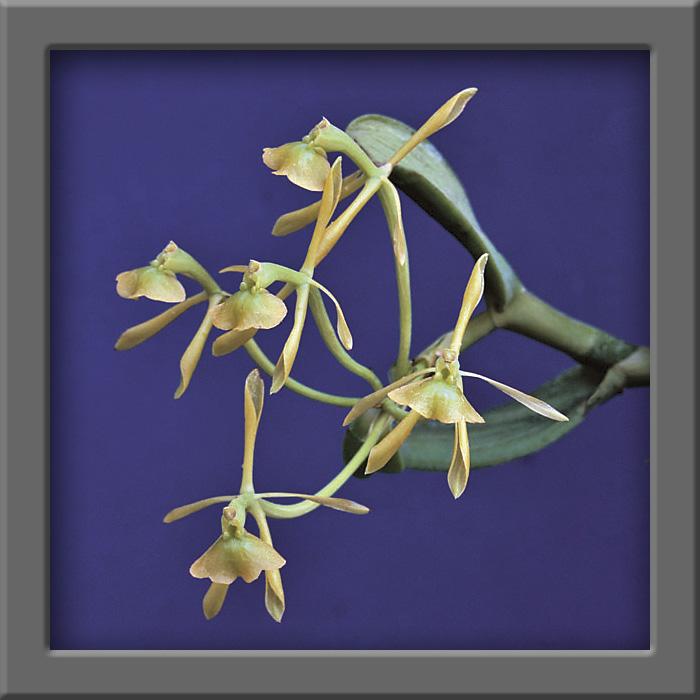

Epidendrum montis-narae Pupulin & L.Sánchez 2001 GROUP Difforme
Photo by © Franco Pupulin.
TYPE Drawing by © Jimenez, Hágsater & E.Santiago and The AMO Herbario Website





Common Name The Mount Nara Epidendrum [A mountain in Costa Rica]
Flower Size 1 1/2" [3.75 cm]
Found in Costa Rica in premontane rain forest to cloud forest and disturbed primary forests at elevations around 85 to 1100 meters as a medium to large sized, hot to just cool growing epiphyte with simple, cane-like, slightly laterally compressed, slightly flexuous stem carrying 4 to 8, throughout the stem, erect, elliptic to ovate-elliptic, unequally bilobed, subcoriaceous leaves that blooms in the spring on a terminal, flowering only once, sessile, subcorymbose inflorescence with 5 to 7, simultaneous, resupinate, nocturnally fruity fragrant flowers.
Epidendrum montis-narae is part of GROUP Difforme which is characterized by the caespitose, sympodial plants, fleshy, pale green to glaucous leaves, apical inflorescence, sessile, rarely with a short peduncle, single to many-flowered, and then corymbose, without spathaceous bracts, fleshy, green to yellowish-green rarely white flowers. The species can be recognized by its somewhat laterally compressed stems, ovate-elliptic, suberect leaves, 5 to 7, green to yellowish-green flowers, elliptic-oblanceolate, acute sepals, linear-ligulate, acute petals, 3-robed lip, subreniform to transversally elliptic when spread, semiorbicular-transversly elliptic, entire lateral lobes, midlobe forming two small lobules, with a shallow sinus, apiculate. It is similar to Epidendrum hameri Hágsater & L. Sánchez, from the Pacific slopes of the Volcán Mombacho in Nicaragua, but that species has imbricating upper leaves, 1 to 2 small, very pale yellow-green translucid flowers, obovate, rounded sepals, linear-oblanceolate, rounded petals, and dolabriform, crenate lateral lobes of the lip, with the midlobe separated from the lateral lobes by wide sinuses. Epidendrum citrosmum Hágsater, another similar species from the Pacific slopes, endemic to the semideciduous and deciduous forests of the Sierra Madre in southern Mexico, has terete stems, bright green flowers, rounded sepals and petals and a reduced, entire clinandrium hood. Epidendrum vulgoamparoanum Hágsater & L. Sánchez from the Pacific watershed of Costa Rica and Panama, found in seasonally dry and secondary forests along the Pacific coast has taller plants and larger flowers with elliptic to ovate leaves, a widely obovate, obscurely 3-lobed lip with many thickened veins; the midlobe is obscurely biloed, and the prominent clinandrium-hood is erose-fimbriate." Hagsater etal 2007
Synonyms Epidendrum concavilabium C.Schweinf. 1937
References W3 Tropicos, Kew Monocot list , IPNI ; *Lankesteriana 1:7. 2001; Manual de las Plantas de Costa Rica Vol 3 Hammel, Grayum, Herrera and Zamora 2003; Vanishing Beauty, Native Costa Rican Orchids Pupulin 2005 photo fide; Icones Orchidacearum 9 Plate 960 Hagsater 2007 drawing fide
-------------------------------------------------------------------------------------------------------------------------